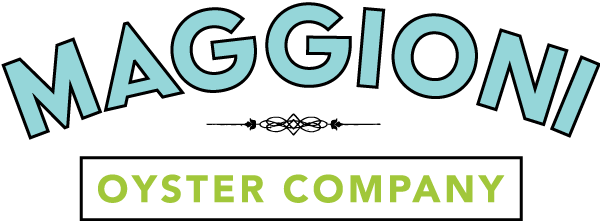cultivate June through September
Cultivation Is Vital to Promote Healthy Oyster Reproduction.
Maggioni Oyster Company harvests a considerable amount of oysters to supply our loyal customer base throughout the eight-month season. It is mandatory that the beds are cultivated thoroughly every off-season to promote healthy reproduction. Our cultivation months are typically June through September. Here’s how we do it!
maggioni Cultivation techniques
1. Rake Down
We gently use a potato rake to pull healthy oysters from the marsh line down into the grow zone where they can obtain a better balance of water (to eat) as well as sunlight to kill off bacteria. Too much sun can kill the oysters up top — and not enough sun allows bacteria to grow. The best grow zone is right in the middle where the subtidal oysters attain a balance of both sun and water.
2. Relay
Maggioni Oyster Company relocates thick congested oysters to areas to promote new growth.
From Left: Congested oysters are relocated to promote new bed growth; Tomato sticks, dead shell and relayed live oysters all planted together. +++ Click image to enlarge
3. Planting
We plant bamboo and tomato farm sticks which are both DNR approved materials. A barnacle will attach to the stick and then the oyster larvae will attach to the calcium-rich barnacle. Once the oyster growth has taken over the stick, we can either knock it over or chop off and spread the oysters. We leave the stick to — hopefully — catch another set of larvae. Either way it is a spectacular method used to promote new growth. It’s all hit and miss finding good spots so we try multiple locations and eventually embellish the areas where proof of growth is the best.
From Left: Loading up tomato sticks and dead shell for planting; Planting tomato sticks; Oysters taking hold and growing on bamboo-twelve months of growth. +++ Click image to enlarge.
4. Green cultch deposit
When we clean, process and package our oysters there is often small amounts of live small oysters and shell left over— this is called green cultch. We either save the green cultch in our cooler to redeposit it once a week or we give to a picker to deposit the next day.
Green clutch ready for redeposit. +++ Click image to enlarge.
5. Dead shell deposit
We usually have some dead shell that environmentally conscious customers return to us after their oyster roasts. We use this shell to reinforce healthy beds, promote new growth on thin beds, or to provide a substrate (hard floor on the mud) that we can relay live clusters or green cultch to.
From Left: We load up buckets of dead shell that is returned from environmentally conscious customers; Oysterman deposits shell to extend a bed; Extended bed. +++ Click image to enlarge.
6. Drag
When there are tall congested oysters on an extremely long bed, we attach a ten foot piece of chain link fence to our boat, and drag it over beds at high tides. This process breaks them up and spreads them around. We typically drag an area first, we follow-up with a gentle rake down, and then we break em’ up and spread em’ around.
Fence and boat prepped for drag. +++ Click image to enlarge.
